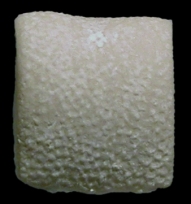 A A |
 B B |
|
Metopaster vs. Crateraster |
The two most commonly encountered Asteroid taxa in the British Chalk are Metopaster (e.g. Metopaster parkinsoni) and Crateraster (e.g. Crateraster quinqueloba). They are superficially very similar, most complete individual being small, with poorly developed and slightly upturned arms and a robust marginal frame. However, on closer inspection the two genera can be easily distinguished. Firstly the marginal ossicles of Metopaster have a distinct ornament; a raised central area, creating a recessed border around the margin of the ossicle. This central area is of highly variable width, but is usually quite consistent for any one individual. Secondly, the arm tips of Metopaster have an enlarged ultimate superomarginal, with several corresponding inferomarginals. Crateraster has an equal number of superomarginals and inferomarginals, and the ossicles have no border.
The Campanian-Maastrichtian genus Recurvaster is a descendent of Metopaster, possessing the same recessed-border ornament, but with an equal number of inferomarginals and superomarginals like Crateraster, and no enlarged ultimate superomarginal (compare Metopaster and Recurvaster).
1). Typical marginal ossicles (x7); (A) Crateraster quinqueloba, no border is present; (B) Metopaster parkinsoni, a well defined border is present.
2). Side profiles (x3); (A) Crateraster quinqueloba, an even number of superomarginals and inferomarginals; (B) Metopaster parkinsoni, an enlarged ultimate superomarginal with several corresponding inferomarginals.
3). More examples of Metopaster arm tips, displaying variably developed ultimate superomarginals; (A) M. uncatus, small individual; (B) M. uncatus, large individual; (C) M. hunteri.